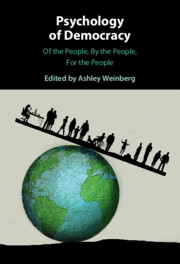Book contents
- Psychology of Democracy
- Psychology of Democracy
- Copyright page
- Contents
- Figures
- Tables
- Contributors
- Preface
- Acknowledgements
- Chapter 1 Psychology of Democracy
- Part I Of the People
- Part II By the People
- Part III For the People
- Chapter 14 Democracy as a Moral Challenge
- Chapter 15 ‘Can I Trust My Future?’
- Chapter 16 Religious Identity Politics and Genuine Support for Democracy
- Chapter 17 Psychology, Democracy and the Media
- Chapter 18 A Social Psychological Approach to Understanding China’s Democratisation
- Chapter 19 The Psychology of Radicalised Conceptions of Democracy
- Index
- References
Chapter 17 - Psychology, Democracy and the Media
Are Citizens Learning from the News? A Self-Regulated Learning Perspective
from Part III - For the People
Published online by Cambridge University Press: 24 February 2022
- Psychology of Democracy
- Psychology of Democracy
- Copyright page
- Contents
- Figures
- Tables
- Contributors
- Preface
- Acknowledgements
- Chapter 1 Psychology of Democracy
- Part I Of the People
- Part II By the People
- Part III For the People
- Chapter 14 Democracy as a Moral Challenge
- Chapter 15 ‘Can I Trust My Future?’
- Chapter 16 Religious Identity Politics and Genuine Support for Democracy
- Chapter 17 Psychology, Democracy and the Media
- Chapter 18 A Social Psychological Approach to Understanding China’s Democratisation
- Chapter 19 The Psychology of Radicalised Conceptions of Democracy
- Index
- References
Summary
This chapter discusses how news contributes to informed citizenship by reviewing the different approaches adopted in the literature to understanding how individuals learn from the news. After reviewing the main theoretical and empirical perspectives on how news contributes to citizens’ ‘knowledge’, we advance the hypothesis that adopting a self-regulated learning perspective might provide a more comprehensive theoretical framework for this type of research. We therefore propose a GAMES approach (Goal-Oriented, Active, Motivated, Emotion-Laden, Situated), derived from a synthesis of the literature on self-regulated learning in the field of educational psychology.
- Type
- Chapter
- Information
- Psychology of DemocracyOf the People, By the People, For the People, pp. 377 - 402Publisher: Cambridge University PressPrint publication year: 2022



